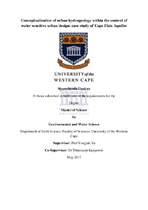| dc.description.abstract | Urban hydrogeology can be used to facilitate a decision-making process regarding the
implementation of water sensitive urban design (WSUD) to manage water systems of periurban
cities. This thesis was aimed at providing explanation of how that approach can be
applied in Cape Town using Cape Flats Aquifer as a case study. To achieve this main
objective, three specific objectives were set, namely, objective 1 which focused on estimating
aquifer parameters using Theis analytical flow solution, in order to identify areas for
implementation of managed aquifer recharge (MAR) suggested by WSUD principles;
Objective 2 focused on conceptualizing groundwater flow system of Cape Flats Aquifer using
the Finite Difference Method (FDM), in order to predict aquifer behaviour under stresses
caused by the implementation of WSUD; Objective 3 focused on assessing gw-sw interaction
using Principal Aquifer Setting, environmental isotope, and hydrochemical analysis, in-order
to identify where and when groundwater surface water interaction is occurring, and thus
informing the prevention strategies of the negative effluence of such exchanges on WSUD.
The analysis of data collected through pumping test approach which were conducted in
March, October 2015 and June 2016, showed that average transmissivity ranged from
15.08m2/d to 2525.59m2/d, with Phillipi Borehole (BG00153) having the highest and
Westridge borehole 1 (G32961) having the lowest transmissivity values based on Theis
solution by Aqua test analysis. Theis solution by excel spreadsheet analysis showed that
average transmissivity ranged from 11.30m2/d to 387.10m2/d with Phill (BG00153) having
the highest transmissivity and Bellville 2 (BG46052) having the lowest transmissivity.
Storativity values ranged from 10-3 to 10-1 with Phillipi borehole (BG00153) having the
highest storativity and Lenteguer borehole 1(BG00139) having the lowest values from both
analysis. Average transmissivity visual maps showed that highest transmissivity values
within the Cape Flats Aquifer can be obtained around the Phillipi area towards the southern
part of the aquifer. Storativity maps also showed that the greatest storativity values can be
obtained around Phillipi and Lenteguer area. These findings reveal that MAR would be
feasible to implement around the Phillipi and Lenteguer area, where aquifer storage and
discharge rates are higher. | |

